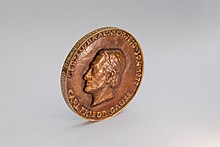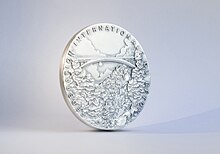|
Manfred Curbach
 Manfred Curbach (born 28 September 1956 in Dortmund) is a German civil engineer and university professor. He is a leading researcher in the development of textile-reinforced concrete and carbon reinforced concrete respectively. Life and careerManfred Curbach completed his A Levels in June 1976 at the Albert-Einstein-Gymnasium in Dortmund. From 1977 to 1982 he studied Civil Engineering at the Technische Universität Dortmund, specialising in structural engineering. In 1980 he was admitted to the Studienstiftung des Deutschen Volkes (German Academic Scholarship Foundation of the Federal Republic of Germany). After his graduation, he took up the scholarship to work for David. P. Billington at the University of Princeton (USA) doing research on "Bridge construction in the USA" and "Robert Maillart". From 1982 to 1988, Manfred Curbach was Josef Eibl's research assistant, first at the University of Dortmund and later at the University of Karlsruhe, where he also received his doctorate in 1987. In 1988 he started working as project manager at the Ingenieurbüro Köhler + Seitz where he was also a partner from 1994 to 2004. Since August 1994 Manfred Curbach holds the professorship for the Institut für Massivbau (Institute of Concrete Structures) at the Technische Universität Dresden, which is still his main field of activity today. Since 1997 he is registered as test engineer for structural analysis, specialising in concrete structures. In 2005 he started a new engineering company Curbach Bösche Ingenieurpartner, Dresden.[2] In December 2014 the company CarboCon GmbH was founded which specialises in design, construction, calculation and building with carbon reinforced concrete. Curbach is one of the three founding partners. ResearchTextile and carbon reinforced concreteManfred Curbach concentrates on basic research and application-oriented research for the development of textile and carbon reinforced concrete with the aim to establish it in the building industry. From 1999 to 2011 Curbach was the spokesman for the Collaborative Research Centre 528 "Textile reinforcements for structural reinforcement and repair". As part of this research programme, the new composite material, made of high-strength fine concrete and high-performance fibres (made of different materials such as alkali-resistant glass, later mainly carbon fibres), was developed and researched, as well as transferred into practice by pilot projects in cooperation with construction companies. Since July 2020 Manfred Curbach is spokesman of the Collaborative Research Center/Transregio (SFB/TRR) 280 "Design strategies for material-minimized carbon reinforced concrete structures – Foundations for a new way of building", funded by the German Research Foundation DFG. Involved are the Technische Universität Dresden, RWTH Aachen and IPF Dresden. While previous research projects investigated the fundamentals and the applicability of the new material carbon reinforced concrete, this SFB/TRR investigates new construction strategies for carbon reinforced concrete in a total of 17 subprojects. The aim is that the new material composite carbon reinforced concrete will not only replace the previously used reinforced concrete, but that new ways of construction will be found that are specifically tailored to the properties of carbon concrete in order to really exploit the full performance potential of this novel building material.[3] Curbach is the head of a consortium of one of ten Zwanzig20-projects, funded by the German Ministry of Education and Research with up to 45 million euro.[4] The consortium C3 – Carbon Concrete Composite pursues the goal to introduce a completely new design with carbon reinforced concrete (CarbonBeton).[5] Further fields of research are the material behaviour of concrete under multiaxial load or at high loading rates. ImpactManfred Curbach also works on the subject of high-speed dynamics/ impact for concrete and concrete structures and has established a worldwide recognised centre of competence on this topic.[6] MultiaxialCurbach produced significant results on the multiaxial loading of concrete, especially ultra-high-strength concrete, and built up a research group for this experimentally and theoretically very challenging topic.[7] BridgesWith the organisation of the annual Dresdner Brückenbausymposium Curbach succeeded in establishing a national and international centre and meeting place for bridge construction engineers.[8] This symposium as well as the design, calculation and construction of large bridges, has had a lasting influence on bridge construction. History of concrete constructionDue to the research of the national and international history of concrete construction the civil engineering community worldwide experiences an increasing awareness for their own history.[9] MembershipsSince 1999 Manfred Curbach has been a member of the scientific advisory board of the magazine Beton- und Stahlbetonbau. Since 2010 he is head of the German delegation of the International Concrete Association fib and since February 2012 he is on the review board of the Deutsche Forschungsgemeinschaft (DFG) (German Research Foundation). He is a member of the executive board and the research advisory board of the Deutscher Ausschuss für Stahlbeton (DAfStb) (German Committee for Reinforced Concrete), where he was chairman of the executive board from 2004 to 2012.[10] From 2002 to 2008 he was a member of the senate of the DFG and from 2003 to 2008 chairman of the executive board of the VDI-Gesellschaft, Bautechnik (Association of German Engineers – Division Construction Engineering). Curbach has been a member of the scientific advisory board of the Bundesanstalt für Wasserbau (BAW) (Federal Waterways Engineering and Research Institute) since 2011 and has been its chairman since 2015. Curbach is a member of the editorial board of the magazine "Civil Engineering Design".[11] Curbach is also head of the task group for textile reinforced concrete and the task group for the history of concrete construction for the fib (fédération internationale du béton).[1] Awards On 15 November 2011, Curbach received an honorary doctorate from the Universität Kaiserslautern for his outstanding scientific achievements in structural engineering, his services in the consistent implementation of research results into practice and his exemplary personality. Since June 2013, Curbach has been a member of the Nationale Akademie der Wissenschaften Leopoldina[12] (National Academy of Sciences Leopoldina). In 2017, the honour was bestowed on him to hold the renowned Christmas lecture of the Leopoldina.[13] In September 2014, the VDI-Gesellschaft – Bauen und Gebäudetechnik (VDI-Association – Division Civil Engineering and Building) awarded Manfred Curbach at its annual convention the Wolfgang-Zerna-Medal of Honour for "outstanding achievements in the field of construction technology".[14] In February 2016 Curbach was awarded the George Sarton Medal of the History of Science Society, University of Ghent.[15] In 2016 Curbach was elected to the Sächsische Akademie der Wissenschaften (Saxon Academy of Sciences).[16] In 2016 he received the Deutscher Zukunftspreis together with Chokri Cherif and Peter Offermann, which is awarded by the German Federal President.[17]  At the Saxon Chamber of Engineers Day he was awarded the Wackerbarth Medal for his recognized scientific work and his commitment to the internationally recognized Dresden Bridge Building Symposium in November 2018.[18] At the German Construction Technology Day 2019 in Stuttgart, Manfred Curbach received the Emil Mörsch commemorative coin, donated by the German Society for Concrete and Construction Technology (Deutscher Beton- und Bautechnik-Verein E.V.).[19][permanent dead link] On 10 May 2019 he was awarded the Carl Friedrich Gauss Medal, donated by the Braunschweig Scientific Society (BWG).[20] Since December 2019, Manfred Curbach has been a corresponding member of the engineering sciences class of the Braunschweig Scientific Society.[21] Also in December 2019 he became a full member of acatech – German Academy of Science and Engineering.  On 4 October 2021, Technische Universität Dresden honoured members who have rendered outstanding services and special individual achievements for the good of the university. Curbach received a Golden Badge of Honour for, among other things, his pioneering work in the field of textile and carbon concrete and for a successful term of office in the TUD's Prorectorate of University Development.[22] In February 2022, Curbach was elected fib Fellow 2022 as one of 10 fib members who have belonged to fib – Fédération internationale du béton for at least 10 years, who represent its values and who have actively rendered outstanding services to concrete construction – in teaching, research, design and construction.[23] In May 2023, Curbach was awarded the fib Medal of Merit by fib - Fédération internationale du béton in recognition of his outstanding contributions.[24] Works
PublicationsSelected publications
Publications for the DAfStb ("green booklets")
Further publicationsA detailed list of publications is available on the website of the Institut für Massivbau. References
External links |